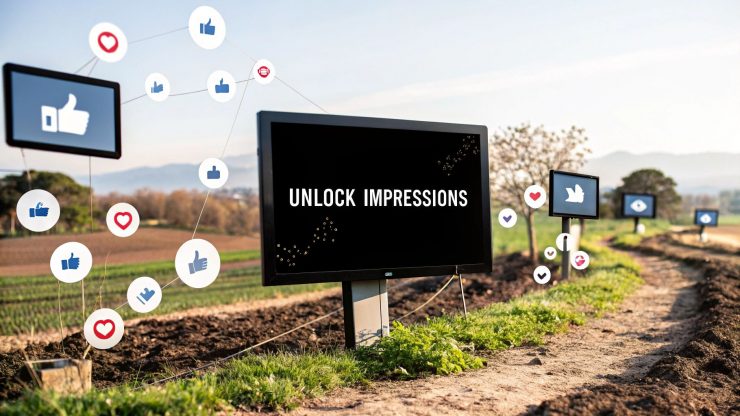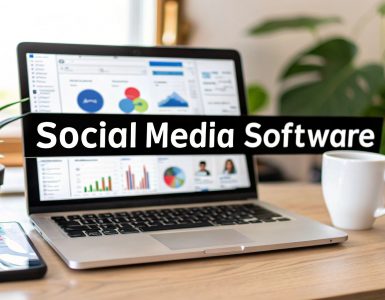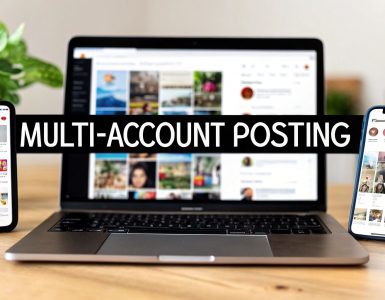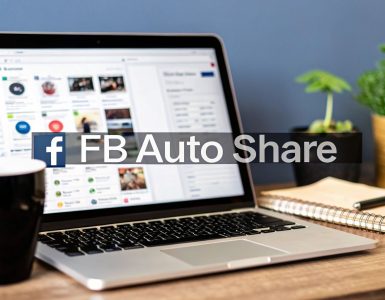Ever wonder what "impressions" really mean on your social media reports? Simply put, an impression is counted every single time your content shows up on someone's screen.
Think of it like a digital billboard on a busy highway. Every car that drives by and has a chance to see your ad counts as one impression. It doesn't matter if the driver looked closely, read the whole thing, or just glanced at it. The opportunity to be seen is what counts.
What Social Media Impressions Really Mean
Let's use a real-world example. Imagine you own a small coffee shop and pin a flyer to a community bulletin board. Every person who walks past that board and has your flyer in their line of sight creates an impression. They don't have to stop and read it; the mere act of it being displayed to them is enough.
That’s exactly how impressions work online. This metric is all about exposure, tallying the total number of times your post, story, or video was delivered into a user's feed. If a single person sees your post three different times throughout the day, that’s three impressions. This is a crucial detail that sets it apart from other metrics.
Impressions vs Reach
This is where things can get a little tricky. People often mix up impressions and reach, but they tell two completely different stories about how your content is performing.
- Impressions: This is the total number of times your content was displayed. It can easily be higher than your follower count because it includes the same person seeing your post multiple times.
- Reach: This is the total number of unique people who saw your content. If that one person sees your post three times, your reach is one, but your impressions are three.
Here’s another way to think about it: Reach is the number of individual people who showed up to your concert. Impressions are the total number of times the stage lights shined on the audience. A high impression count with a relatively low reach often means your content is being shown over and over again to a small but dedicated group of people.
An impression is an opportunity for a view, not a guarantee of attention. It is the first and most fundamental step in the journey from awareness to action, representing every chance your brand has to make a mark.
Getting a handle on this difference is the first step to truly understanding your analytics. Impressions measure the raw volume of your content's distribution, which is a massive signal for brand awareness and how much the platform's algorithm likes your stuff. They set the stage for every other action, from clicks to new followers.
Of course, impressions are just one piece of the puzzle. To get the full picture, you have to look at them alongside other key figures. For a deeper dive, you can explore the most important social media marketing metrics that give your data real context.
How Different Platforms Count Impressions
Trying to nail down what an "impression" means across social media can feel a bit like comparing apples to oranges. Every platform has its own secret sauce for deciding when your content has been officially "seen," which is why your numbers can look so different from one network to the next.
It's not just about different audiences; it's a technical thing. On one platform, a quick scroll-by is enough to count. On another, a user might need to pause for a couple of seconds. These subtle rules of the game have a huge impact on your analytics and, more importantly, how you should be reading your content's performance. Once you know the rules for each platform, you can stop using a one-size-fits-all strategy and start making smarter, more effective decisions.
This visual breaks down the simple journey from a first glance (an impression) to getting your audience to actually interact.
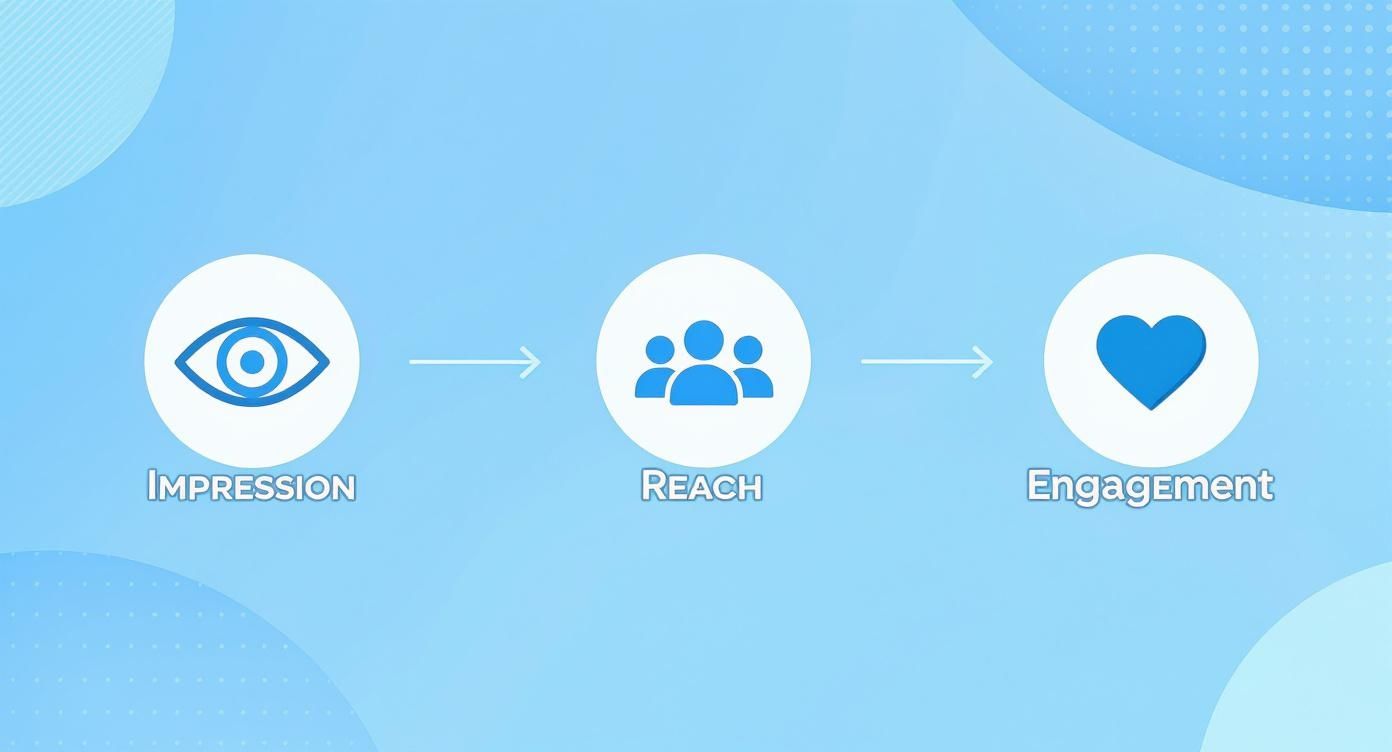
As you can see, the impression is just the starting line. From there, you build reach and, hopefully, earn that coveted engagement.
Let's dig into the specifics for each major player. The table below gives a quick snapshot of how an 'impression' is defined across feeds, stories, and videos.
Impression Calculation Across Major Social Platforms
| Platform | Feed Post Impression | Story Impression | Video View Impression |
|---|---|---|---|
| Instagram & Facebook | Instantaneous; counted as soon as any part of the post appears on-screen. | Counted the moment the Story loads and is displayed. | Counted as soon as the video begins to autoplay, even for a split-second. |
| X (formerly Twitter) | Instantaneous; counted when a Tweet is delivered to a user's timeline or search results. | N/A | Counted once the video plays for 2 seconds with at least 50% of the player in view. |
| Counted when at least 50% of the post is visible for 300 milliseconds. | N/A | Counted once the video plays for 2 continuous seconds with at least 50% of the player visible. | |
| TikTok | N/A (platform is video-first) | N/A | Instantaneous; a 'view' is counted the moment a video starts playing in a feed. |
As you can tell, there's no single standard. A "view" on TikTok is fundamentally different from one on LinkedIn, which is why context is everything when you're looking at your analytics.
Instagram and Facebook Impressions
On Meta's turf—Instagram and Facebook—impressions are counted in the blink of an eye. The second a post hits a user's screen, even if they just scroll past it without stopping, it gets logged as an impression. This goes for everything: feed posts, Reels, and Stories.
Because the bar is set so low, these platforms tend to show really high impression numbers. It's not uncommon for a single person to give you multiple impressions on the same post just by scrolling through their feed a few times.
Key Takeaway: Think of an impression on Instagram or Facebook as proof of delivery. It means your content made it to someone's feed, but it doesn't guarantee they actually saw it. It’s a measure of distribution, not attention.
X (Formerly Twitter) Impressions
X plays by similar rules to Meta. An impression is tallied anytime someone sees your tweet, whether it's on their main timeline, in a search result, or on your profile page. Simple enough.
The big difference, though, is the sheer speed of the X feed. Content moves at a blistering pace. A tweet can rack up a ton of impressions in a short burst, but its lifespan is often incredibly brief. The platform’s algorithm also prioritizes what's happening right now, which has recently caused a big spike in the average impressions a tweet can get.
LinkedIn Impressions
LinkedIn is a bit more discerning. For a standard post to get an impression, at least 50% of it has to be on someone's screen for a minimum of 300 milliseconds. It’s still incredibly fast, but it’s a slightly higher bar than a fleeting scroll-by.
Things get even more specific with video. For LinkedIn to count a video view as an impression, it has to be watched for at least two continuous seconds with 50% or more of the video player visible. This is a crucial detail to remember when you're comparing the performance of your articles, images, and videos on the platform.
TikTok Impressions
On TikTok, the entire world is video, so an "impression" is the same thing as a "view." The count goes up the very instant a video starts to play on someone's "For You" Page. No minimum watch time, no percentage of the screen needed. If it autoplays, it’s an impression.
Since the algorithm is a finely tuned discovery engine designed to serve up a non-stop stream of content, TikTok posts often get the highest average impression counts you'll see anywhere. The sheer scale is mind-boggling. Globally, there are an estimated 5.66 billion social media user identities, with about seven or eight more popping up every single second. You can learn more about the growth of global social media users on datareportal.com. This massive, always-on audience is what makes platforms like TikTok such powerful machines for getting eyeballs on your content.
Why Impressions Are Key to Brand Growth
It’s easy to dismiss social media impressions as a "vanity metric"—a big, flashy number that doesn't really mean anything. But that’s a huge mistake. Impressions are the very foundation of brand awareness and the absolute first step someone takes on their journey with your business.
Think about the classic marketing "Rule of Seven." It's an old idea, but it holds up: a potential customer usually needs to see or hear about your brand at least seven times before they even think about taking action. Every single one of those encounters is an impression. High social media impressions are just the modern way of making sure your brand shows up again and again, planting a seed of familiarity that grows into trust.
This repeated exposure is how you build top-of-mind awareness. When your ideal customer is finally ready to buy, the brand they've seen a dozen times is the one that will pop into their head, not the one they saw once, months ago.
The Feedback Loop for Your Content
Impressions do more than just build recognition; they’re direct feedback from the platform's algorithm. This data tells you exactly which types of content are getting the most visibility and actually making their way into people's feeds.
Impressions are the algorithm’s vote of confidence in your content. A rising impression count is a clear signal that the platform sees value in what you’re sharing and is actively showing it to a wider audience.
Looking at your analytics this way changes everything. If you see a sudden spike in impressions on a video you posted, that’s a loud and clear sign to make more videos. On the flip side, if a certain type of post consistently falls flat, it's the algorithm telling you it's time to rethink that part of your strategy.
Fueling the Growth Engine
Impressions are also the engine that drives almost every other metric you care about, from engagement to follower growth. After all, you can’t get likes, comments, or new followers from people who never see your posts to begin with.
This kicks off a powerful cycle:
- More Impressions: Your content gets in front of a much wider audience.
- Increased Engagement: With more eyes on your posts, you naturally get more chances for likes, shares, and comments.
- Follower Growth: People who keep seeing and enjoying what you share are far more likely to hit that "follow" button.
The opportunity here is massive. Every single day, people around the world spend over 14 billion hours scrolling through social networks. In this crowded space, AI is becoming a go-to tool for creating content that grabs attention. In fact, 73% of businesses using generative AI have seen their engagement rates go up. You can find more stats like this in these social media trends on talkwalker.com.
Ultimately, when you focus on boosting your impressions, you're filling the top of your marketing funnel. You’re creating the initial spark of awareness needed to drive every other meaningful result for your brand.
What Actually Drives More Impressions

Think of a social media algorithm as a lightning-fast talent scout. It's constantly sifting through a sea of content, looking for the next breakout star to put on the main stage—everyone's feed. If you want your content to grab that spotlight and rack up social media impressions, you have to send all the right signals from the second you hit “post.”
It all starts with a small, private audition. The algorithm shows your new post to a handful of your most dedicated followers to see what they do. Do they like, comment, share, or save it? This initial reaction is everything.
If the feedback is positive and quick, the algorithm gets the hint. It sees that immediate engagement as a sign of quality content and starts pushing your post to a wider circle of people. This loop of exposure and positive reaction is what can turn a simple post into a viral hit.
The Power of Early Engagement
Getting likes and comments right away is like a massive vote of confidence for your post. When people jump on it within the first hour, it builds a momentum that algorithms are designed to reward. This initial velocity is a huge tell that you've created something people want to see.
For example, a post that snags 50 likes and 10 comments in the first 30 minutes has a much better shot at being promoted than one that gets the same numbers trickling in over a full day. The speed of the interaction is just as important as the total count.
A key factor in driving more impressions is creating content that genuinely resonates with your audience. For instance, you can explore effective strategies for getting real Twitter likes, which directly contribute to these crucial early signals.
That first burst of activity essentially tells the algorithm, "Hey, this is a good one!" In turn, it starts showing your post to a much broader audience—on Explore pages, in hashtag feeds, and to people who look like your current followers.
Content Quality and Format Choice
Of course, none of this happens without good content. But "quality" is about more than just a pretty picture; it's about providing real value that makes someone stop scrolling. The algorithm's main goal is to keep people on the platform, so it naturally favors content that achieves that.
Right now, certain formats are basically impression-making machines because they are built for engagement and sharing:
- Short-Form Video: Platforms like TikTok and Instagram are all-in on Reels. They’re quick, fun, and often use trending audio, making them incredibly easy to share and capable of reaching huge audiences.
- Carousels and Albums: On Instagram and Facebook, posts with multiple images or slides encourage people to swipe and spend more time with your content. This increased "dwell time" is a powerful signal to the algorithm.
- Polls and Interactive Features: Features like polls and quizzes on LinkedIn and Instagram Stories are a direct line to engagement. They literally ask for a click, generating the exact kind of interaction the algorithm is looking for.
Consistency and Strategic Timing
Finally, algorithms have a soft spot for accounts that post regularly. A consistent schedule trains your audience to look for your content and shows the platform that you’re a dependable creator.
But it’s not just about posting often—it’s about posting at the right time. Dropping your content when your audience is most active gives you the best possible chance of getting that all-important early engagement. Not sure when that is? You can find your ideal posting windows in our guide on the best time to post on social media.
When you combine great content, smart formatting, and a well-timed schedule, you're creating the perfect recipe for the algorithm to pick up your post and show it to the world.
Practical Ways to Increase Your Social Media Impressions
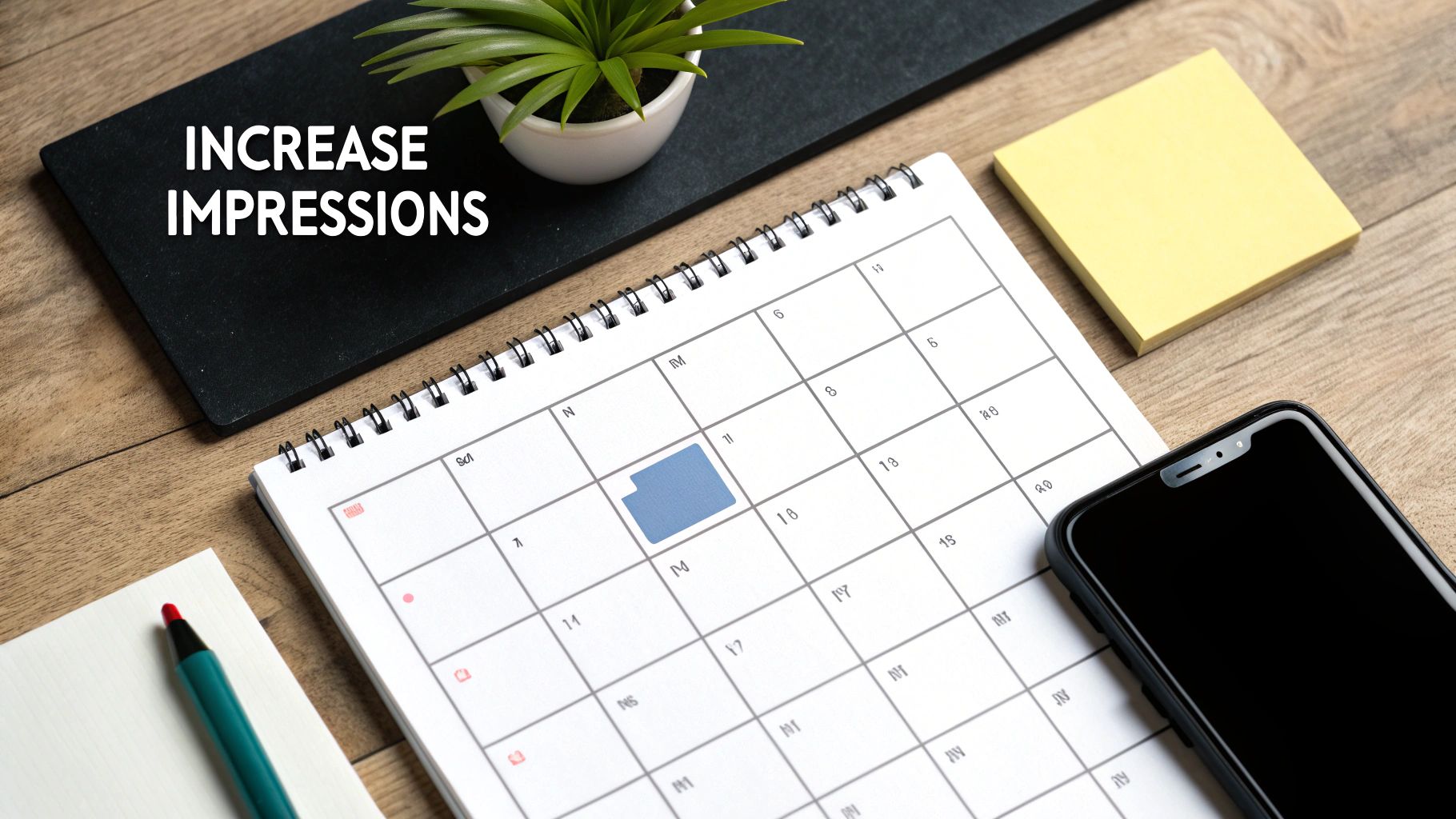
Knowing what impressions are is one thing, but actually getting more of them? That's the real game. Boosting your content's visibility isn't about getting lucky with a viral hit. It's about building a smart, repeatable system that feeds the algorithms what they want while grabbing your audience's attention.
So, let's get into the action plan. These are the proven, no-fluff strategies that will get your content in front of more people and turn your followers into a true marketing engine.
Systematize Your Content for Consistency
Algorithms love a consistent creator. When you post on a reliable schedule, you're not just training your audience to look for your content; you're signaling to the platform that you're an active, valuable account worth showing to more people.
The secret to staying consistent without burning out is to build a content system. A great way to start is with a content library—think of it as your own private stash of evergreen gold. Fill it with quotes, quick tips, snippets from old blog posts, and customer testimonials. Instead of scrambling for a new idea every single day, you can just pull from your library.
Tools like EvergreenFeed are built for this. You can link it to your Buffer account, sort your content into different categories or "buckets," and let it post automatically on a schedule you decide. This creates a steady drip of quality content, keeping your profiles buzzing and racking up social media impressions while you’re busy with other things.
Master Your Posting Times and Frequency
This one is simple but powerful: post when your audience is actually online. When your content goes live during peak hours, it gets that initial burst of engagement the algorithm needs to see before it decides to show it to a wider audience.
Don't just guess when that is. Dive into your platform analytics—every major network has a dashboard that shows you exactly when your followers are most active. Use that data to build your posting schedule. It’s the easiest win you’ll get.
Pro Tip: How often you post is just as important as when you post. You don't want to flood people's feeds, but posting too rarely makes you fall off the algorithm's radar. Find a rhythm that works for your brand and your capacity to create good stuff, and stick to it.
Leverage Platform-Native and Trending Features
Here’s an inside tip: social media platforms want you to use their shiny new toys. They push content that uses features like Instagram Reels, LinkedIn Polls, or interactive Story stickers. Why? Because those features are designed to keep users on the platform longer. Using them often gets you a nice little boost in the algorithm.
Along those same lines, keep an eye on what's trending. Jumping on a trending sound for a TikTok or Reel can expose your content to a massive audience that goes way beyond your current followers. The trick is to find a way to tie the trend back to your brand's message so it feels authentic, not forced.
Try putting these into practice:
- Run a weekly poll on LinkedIn or X (formerly Twitter) asking for opinions on an industry topic.
- Use the question sticker in an Instagram Story to host a quick Q&A.
- Create a short video with trending audio that demonstrates a quick tip or shows off a product.
These tactics do more than just get you impressions; they get your audience involved and make them feel like part of a community.
Turn Your Audience into Amplifiers
Nothing beats the power of user-generated content (UGC). When a happy customer posts about your product, it's a glowing recommendation that instantly reaches their entire network. It's authentic, it's trustworthy, and it introduces your brand to a whole new set of eyes.
You can encourage this by running contests, creating a unique branded hashtag, or just by regularly sharing and celebrating the posts from your fans. This not only gives you a free source of amazing content but also transforms your loyal customers into a volunteer marketing army.
Every tag, share, and mention is a fresh opportunity for impressions. With 5.45 billion people on social media, the potential for this kind of audience amplification is staggering. Considering that users spend an average of 2 hours and 24 minutes a day scrolling, you have plenty of chances to show up in their feeds. If you want to dive deeper into these numbers, check out these game-changing social media statistics on sonary.com.
By weaving these strategies together, you’ll build a powerful system for driving more impressions and growing your brand’s reach.
How to Measure and Benchmark Your Impressions
https://www.youtube.com/embed/Osk_tasL1zA
Tracking your social media impressions without any context is a bit like counting cars on the highway without knowing where they’re going. The numbers are just noise. To turn that noise into a real strategy for growth, you need to know where to find the data, how to make sense of it, and what "good" actually looks like for you.
Every major social media platform gives you a built-in analytics dashboard, usually called "Insights" or "Analytics." This is your command center. Here, you’ll find impression data for individual posts and bigger trends for your account, which you can typically filter by different time periods.
Looking Beyond Raw Numbers
Once you’ve found your data, the real work begins. Raw impression counts are a starting point, but they don't tell the whole story. To get a clearer picture of your content's performance, you need to look at your Impression Rate.
The formula is pretty simple: Impressions ÷ Reach = Impression Rate.
This little calculation tells you the average number of times your content was shown to each unique person who saw it. For instance, an impression rate of 3.0 means that, on average, every person who saw your post saw it three times. A high rate might mean your content is really sticking with a core audience, or it could show that your paid ads are hitting the same users multiple times.
Setting Realistic Benchmarks
So, what’s a “good” number of impressions? Honestly, it depends. There's no one-size-fits-all answer. Your ideal benchmark is shaped by a few key things:
- Your Industry: A specialized B2B software company will have a totally different impression potential than a global fashion brand.
- Your Account Size: An account with 1,000 followers will naturally see much lower numbers than one with 100,000.
- The Platform: Different platforms have different averages. As a general guide, TikTok leads the pack with an average of 6,268 impressions per post, while Instagram hovers around 2,635.
Instead of chasing some magic number, focus on your own progress. Start tracking your average impressions per post every week or month. Your real goal should be steady, consistent growth over time. To really get a handle on what this all means, it's smart to fit your impression data into a larger framework for measuring marketing effectiveness.
The most valuable benchmark is your own historical performance. Aim to beat last month's numbers. This approach transforms impressions from a vanity metric into a clear indicator of progress, showing you which content strategies are effectively expanding your visibility.
Ultimately, keeping an eye on this data is a vital piece of a much larger puzzle. To see how impressions fit into the bigger picture, check out our complete guide on measuring social media success.
Common Questions About Social Media Impressions
Even after you've got the basics down, a few questions about social media impressions always seem to linger. Let's tackle some of the most common head-scratchers so you can move forward with total confidence.
Think of this as the final piece of the puzzle. Once these concepts click, you'll be ready to put everything you've learned into action.
What Is the Real Difference Between Reach and Impressions?
This one trips up everyone, so let's settle it once and for all with a simple analogy. Imagine you’ve put up a billboard on a busy highway.
- Reach is the number of unique cars that drive past your billboard. If 1,000 different cars pass by in a day, your reach is 1,000.
- Impressions are the total number of times your billboard is seen. If a commuter drives past it on their way to work and again on their way home, that's one person reached but two impressions.
So, impressions count every single time your content pops up on a screen, even if it's the same person seeing it over and over. Reach, on the other hand, only counts each unique viewer one time.
Are More Impressions Always a Good Thing?
Not always. A huge impression number looks great on paper, but it doesn't tell the whole story. It's like having a commercial air during the Super Bowl—millions of people see it (that's massive impressions), but if nobody remembers your brand or buys your product, what was the point?
High impressions paired with low engagement can be a warning sign. It often means your content is being served to a broad audience but isn't resonating enough to make them actually stop and interact. It’s like shouting into a crowded room; lots of people might hear you, but is anyone listening?
Impressions create the opportunity. Engagement is what you do with it. A truly successful strategy needs a healthy dose of both.
How Long Does It Take to See More Impressions?
Boosting your impression count isn't like flipping a switch; it's more like planting a garden. You have to consistently put in the work before you see real growth. When you start a new content strategy, you're essentially showing the platform's algorithm that your posts are worth sharing.
Generally, you can expect to see a noticeable upward trend after three to six weeks of consistent, high-quality posting. The algorithms favor reliability. When you stick to a schedule and consistently deliver value, you're building trust with the platform, which it rewards with a slow but steady increase in your visibility.
Ready to put your content on autopilot and boost your impressions without the extra work? EvergreenFeed automates your posting schedule, ensuring your best content is consistently shared at the perfect times. Start your free trial today and watch your visibility grow.

